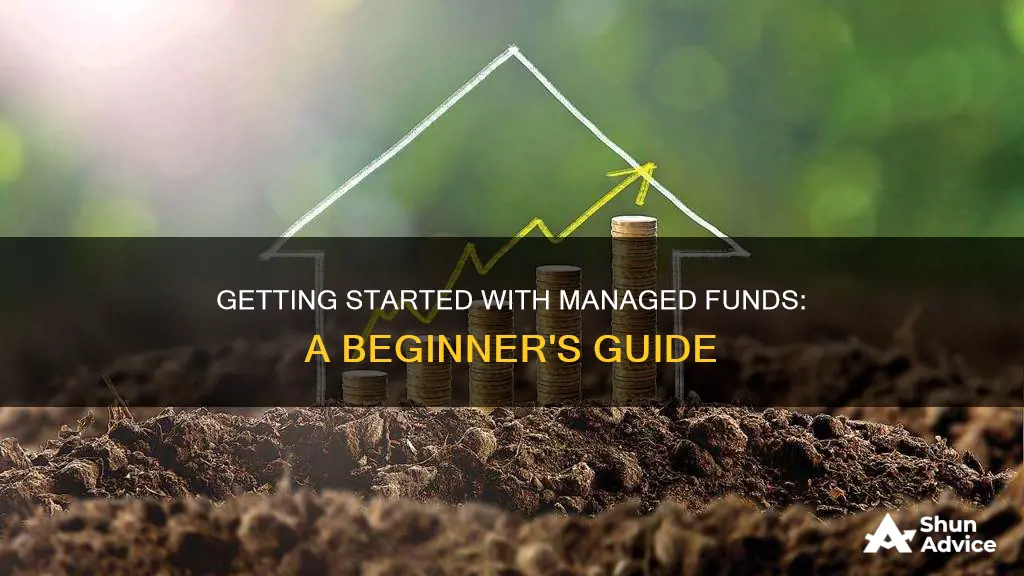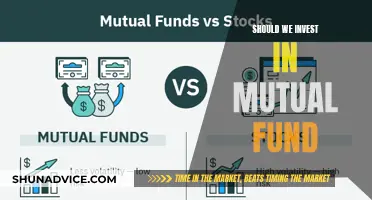
Investing in managed funds can be a great way to get started with investing, especially if you're a beginner. Managed funds are investment funds that are actively managed by fund managers on your behalf. The whole idea behind them is that you can leave your money to be invested by someone else in a collective investment scheme, and that these professionals will make money on your behalf.
There are two types of managed funds: actively managed funds and passively managed funds. In actively managed funds, the fund manager selects the stocks based on their own convictions, while passively managed funds tend to be lower cost and aim to match the performance of a benchmark.
When investing in managed funds, it's important to consider the fees involved, as these can eat into your overall returns. You should also assess whether the fund's objectives match your own investment goals and risk tolerance.
Managed funds can provide access to a diversified portfolio of securities for a relatively small minimum investment, making them a great option for those looking to get started with investing.
| Characteristics | Values |
|---|---|
| Definition | Pooled investments managed by professional money managers. |
| Investment Vehicle | Pools money from multiple investors to purchase a diversified portfolio of stocks, bonds, or other securities. |
| Benefits | Access to diversified, professionally managed portfolios; instant diversification; simplicity; affordability; liquidity; ease of buying and selling; relatively low risk; good for beginners and experienced investors. |
| Drawbacks | High fees, commissions, and other expenses; large cash presence in portfolios; difficulty in comparing funds; lack of transparency in holdings; potential for value depreciation; tax implications; early redemption fees. |
| Types | Single asset; mixed asset or multi-sector; stock; money market; bond; target-date; index; passive; active. |
| Fees | Annual fees; expense ratios; commissions; establishment fee; contribution fee; management fees and costs; performance fee; adviser service fee; transaction fees; withdrawal fees; sales charges or loads; redemption fees; account fees; loads; no-load funds. |
What You'll Learn

Understand the different types of managed funds
Managed funds are investment funds that are actively managed by fund managers on your behalf. There are thousands of managed funds to choose from, and it's important to understand the different types of funds, their risks and returns. Here is a detailed overview of some of the most common types of managed funds:
Single Asset Managed Funds
These funds invest in a single class of assets, such as shares, property, or bonds. Examples include:
- Cash or Money Market Funds: These funds invest in very low-risk, short-term investments, such as short-term money market deposits, government bonds, and bank bills. They are considered low risk but also have lower returns.
- Fixed Interest or Bond Funds: These funds generally invest in low-risk investments, including government bonds, bank bills, or mortgage-backed securities. Some funds may invest in corporate bonds, which can be higher risk.
- Mortgage Funds: These funds invest in property loans (mortgages). The risk depends on the quality of the borrowers and the purpose of the loan. There is no increase in the value of your investment, but you receive income as long as the borrower pays interest.
- Property Funds: These funds invest in residential, commercial, or developmental property. Some property funds are high risk, and there may be restrictions on withdrawing your money from the fund at short notice.
- Share (Equity) Funds: These funds invest in listed companies and offer the potential for higher returns, but they also carry higher risk.
Alternative Investment Funds
These include hedge funds and funds that invest in private equity, derivatives, and commodities. They are typically high risk, and financial advice should be sought before investing.
Mixed Asset or Multi-Sector Managed Funds
Mixed asset funds invest in a range of assets and are labelled based on the types of investments that make up the majority of the fund portfolio. They can provide a mix of shares, property, cash, and fixed interest, offering diversification and potentially lower risk.
Actively Managed Funds
In these funds, the manager selects the stocks based on their own convictions and goals. Actively managed funds aim to outperform a market index, such as the S&P 500. They often come with larger fees to pay for professional management, and they may not always outperform the benchmarks they aim to beat.
Passively Managed Funds
Passively managed funds, such as exchange-traded funds (ETFs), tend to be lower-cost and aim to match the performance of a benchmark rather than beat it. They do not require an expensive investment team as they are not trying to identify the best-performing stocks. This allows them to charge very low fees and sometimes no fees at all, leaving more of the returns for investors.
Mutual Fund Tax Efficiency: Strategies for Savvy Investors
You may want to see also

Learn about the costs and fees
When investing in managed funds, it is important to understand the costs and fees involved, as these can significantly impact your overall returns. Here is a breakdown of the common fees and expenses associated with managed funds:
- Management fees: Managed funds typically charge an annual management fee, which is applied as a percentage of the assets in the fund, usually ranging from 1% to 1.5%. This fee covers the cost of the fund manager and other administrative expenses. It is important to note that this fee is levied regardless of the fund's performance.
- Brokerage fees: These are the costs incurred by the fund when buying or selling assets, such as stocks or bonds. These fees are usually included in the management fee but sometimes may be charged separately.
- Custody fees: These are the costs associated with holding and safeguarding the assets of the fund, such as storage and insurance costs.
- Administration fees: These cover the day-to-day operational costs of running the fund, including record-keeping, accounting, and legal services.
- Performance fees: Some fund managers may charge an additional fee if the fund outperforms a specific benchmark or target return. This is an incentive for the manager to generate strong returns.
- Advisory fees: If you seek financial advice or use the services of a financial advisor to select and manage your investments, you may incur ongoing advisory fees, typically ranging from 1% to 2% per year.
- Transaction fees: Some funds may charge fees for transactions such as contributions, withdrawals, or changing investment options. These fees can vary depending on the fund and the nature of the transaction.
- Early redemption fees: Mutual funds may charge a fee if you sell or redeem your shares within a specified period, usually within 30 to 180 days of purchasing them. These fees are designed to discourage short-term trading and promote long-term investment.
- Sales charges or loads: Some mutual funds may charge sales fees, known as "loads", when you buy or sell shares. Front-end loads are charged upfront when you purchase shares, while back-end loads are assessed if you sell your shares before a certain date. No-load funds, on the other hand, do not charge any sales commissions.
It is important to carefully review the fund's prospectus or product disclosure statement (PDS) to understand all the fees and expenses associated with the managed fund. Small differences in fees can have a significant impact on your investment returns over time. Additionally, consider negotiating the fees with the fund manager or your financial advisor to potentially reduce the costs.
Invest in Abakkus Emerging Opportunities: A Guide
You may want to see also

Research fund manager performance
When investing in managed funds, it's important to research fund manager performance to ensure you're making a sound investment decision. Here are some detailed tips to help you research and evaluate fund managers' performance:
- Check qualifications and experience: Most fund managers are highly educated and possess relevant credentials and management experience. Look for fund managers with a Chartered Financial Analyst (CFA) designation, which indicates expertise in investment analysis and portfolio management. Experience is also key; long-tenured fund managers like Albert "Ab" Nicholas, who managed the Nicholas Fund for over four decades, can provide valuable stability and insights.
- Evaluate investment style: Before investing, review the fund manager's investment style to ensure it aligns with your own goals and risk tolerance. Fund managers can be active or passive. Active managers aim to outperform the market and peers, while passive managers take a more hands-off approach, mirroring benchmark indexes.
- Assess performance history: Check the fund manager's track record over a long-time horizon, such as 5 to 10 years. While past performance doesn't guarantee future results, it gives you an idea of their ability to generate consistent returns. Be cautious of funds that promise high returns but have a short performance history.
- Understand associated risks: Recognise the risks associated with the fund manager's investment strategy. Experienced fund managers often have lower exposure to market, size, and momentum risk factors. Additionally, when a manager has a personal stake in the fund, they tend to exhibit more conservative risk-taking behaviour.
- Compare against benchmarks: Compare the fund's performance against relevant market indexes and similar funds to assess how it stacks up. This will help you determine if the fund is keeping pace with its peers and the overall market.
- Analyse fees: Managed funds charge various fees, including management fees, performance fees, and adviser service fees. While fees are inevitable, be mindful that they can significantly impact your returns over time. Compare fees across different funds to find the most competitive rates.
- Consider independent sources: Websites like The Armchair Trader provide independent information about fund managers and their funds. Relying on independent sources can offer valuable insights and help you make a more informed decision.
- Monitor ongoing performance: By law, fund managers must provide updates on the fund's performance at least annually. Regularly review these reports to understand how your investment is doing and if it's helping you achieve your financial goals.
A Guide to Index Funds Investing in the Philippines
You may want to see also

Know how to buy and sell funds
When you invest in a managed fund, you are buying 'units' in a managed investment scheme or 'shares' in a Corporate Collective Investment Vehicle (CCIV). The number of units or shares you get depends on the unit or share price at the time you invest. The unit or share price changes depending on the value of the assets the fund invests in. With most managed funds, you'll need a minimum amount to invest, for example, $5,000.
Managed funds are investment funds that are actively managed by fund managers on your behalf. They follow a wide range of investment strategies, investing in public markets and other assets such as unlisted companies and real estate to seek to achieve returns for investors. The whole idea behind them is that you can leave your money to be invested by someone else in a collective investment scheme, and that these professionals will make money on your behalf.
You can buy and sell managed funds through an online brokerage, many of which offer a broad selection of funds across a range of fund companies. You can also buy directly from the company that created the fund, such as Vanguard or BlackRock, but doing so will limit your choice of funds. You can also work with a traditional financial advisor to purchase funds, but it may incur some additional fees.
When deciding where to buy your managed funds, you should consider:
- Affordability: Mutual fund investors can face two kinds of fees: from their brokerage account (transaction fees) and from the funds themselves (expense ratios and front- and back-end “sales loads”).
- Fund choices: Workplace retirement plans may carry only a dozen or so mutual funds. You may want more variety than that. Some brokers offer hundreds, even thousands, of no-transaction-fee funds to choose from, as well as other types of funds like ETFs.
- Research and educational tools: With more choice comes the need for more thinking and research. It's vital to pick a broker that helps you learn more about a fund before investing your money.
- Ease of use: A brokerage's website or app won't be helpful if you can't make heads or tails of it. You want to understand and feel comfortable with the experience.
Managed funds can be bought and sold on an exchange, such as the ASX. The unit or share price of a listed managed fund can be higher or lower than the net asset value (NAV) of the fund.
You can cancel a managed fund transaction before 12 pm on the day the trade is placed.
When buying and selling managed funds, you will need to navigate to the "Place an Order" screen and determine how your purchases will be paid for. You can select from the following options:
- Available cash (default)
- Use available cash to pay for asset purchases
- Select a maximum amount of available cash to pay for asset purchases (this amount can be greater than the available cash amount, but the trade will not happen until there is enough cash in the account)
- Use the proceeds from any proposed asset sales to pay for asset purchases
- Available cash and proceeds of sale
- Use available cash plus the proceeds from any proposed asset sales to pay for asset purchases
- Set a fixed total sales amount and the selected assets will sell down at the percentage they are held
You can then decide whether to sell the entire holding or a specific parcel within a specific asset.
To sell all holdings in the portfolio, click on ‘Sell All’ next to the add investment field. To sell all parcels within a specific asset, click the ‘Sell’ button, and in the ‘Amount’ field, choose to sell a specific dollar amount or a percentage of the asset value. To sell one or more parcels within a specific asset, click on the ‘cross’ icon to the left of the asset name to view all individual parcels, click the ‘sell’ button at the asset level to deselect it, then click the ‘Sell’ button for the individual parcel and in the ‘Amount’ field, choose to sell a specific dollar amount or a percentage of the asset value.
You can then submit the transaction electronically or print an authority to proceed to get signed by your client.
When buying an asset or model, you can buy single assets or buy assets in a model portfolio. To buy single assets, click in the ‘Add Investment’ field and the name or code of the asset you want to purchase, then select it, and it will appear in the list below. To buy assets in a model portfolio, click in the ‘Add Investment’ field and search for the name of the model you wish to add, then select it, and it will appear in the list below.
Index Funds: A UK Investor's Guide to Getting Started
You may want to see also

Compare managed funds with other investment options
Managed funds are a type of investment where your money is pooled with other investors. A fund manager then buys and sells assets such as cash, shares, bonds, and property on your behalf. There are two types of managed funds: actively managed funds and passively managed funds. Actively managed funds are picked by a professional money manager who tries to beat the market returns. Passively managed funds, on the other hand, tend to be lower-cost funds that aim to match the performance of a benchmark.
Compared to other investment options, managed funds offer a few key advantages. Firstly, they provide access to a diversified portfolio of assets that would otherwise be difficult for individual investors to access. This diversification helps to mitigate the risk of certain assets performing poorly. Secondly, managed funds offer the expertise of professional fund managers, who have the knowledge and experience to make informed investment decisions. This can be especially beneficial for investors who do not have the time or skills to manage their own investments. Additionally, managed funds have a lower entry cost compared to buying shares directly, making them more accessible to a wider range of investors.
However, it is important to consider the fees associated with managed funds, as they can vary greatly and have a significant impact on overall returns. Some common fees include establishment fees, contribution fees, management fees, performance fees, and adviser service fees. These fees are charged regardless of whether the fund makes or loses money, and they can increase the size of losses.
When comparing managed funds with other investment options, such as individual stocks or bonds, it is worth considering the level of diversification, professional management, and cost. Individual stocks or bonds may offer higher potential returns but also carry higher risk. They may also require more time and knowledge to manage effectively. Additionally, the entry cost for buying shares directly is typically higher than the cost of investing in a managed fund.
In summary, managed funds offer the benefits of diversification, professional management, and lower entry costs. However, it is important to carefully consider the fees associated with managed funds and compare them with the potential returns and risks of other investment options to make an informed decision.
A Simple Guide to Investing in the Nasdaq 100 Index Fund
You may want to see also







